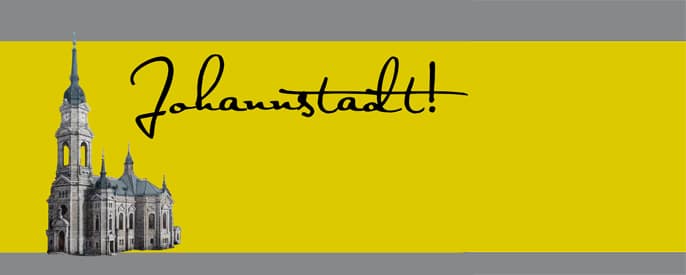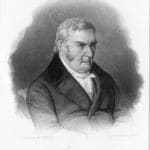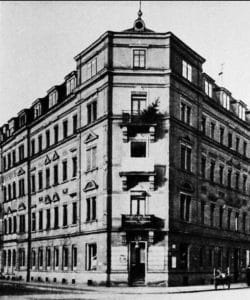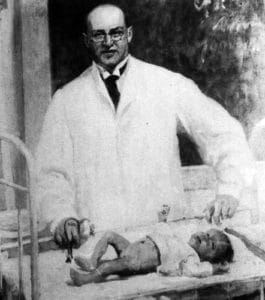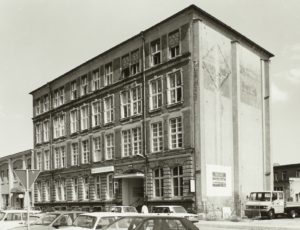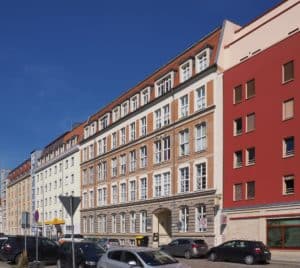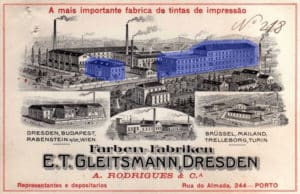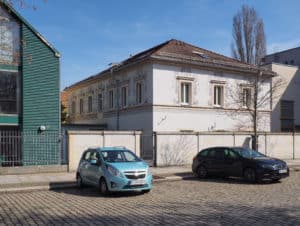Diese Seite ist mehrsprachig verfügbar: English, Русский, عربي.
Biegen Sie nach rechts in die Pfotenhauerstraße, queren Sie diese auf Höhe der Apotheke und biegen Sie in die Arnoldstraße. Hier erreichen Sie den Standort Nr. 5 des historischen Rundwegs.
Vor 1945: Fürsorge, Fahrzeuge und Farben
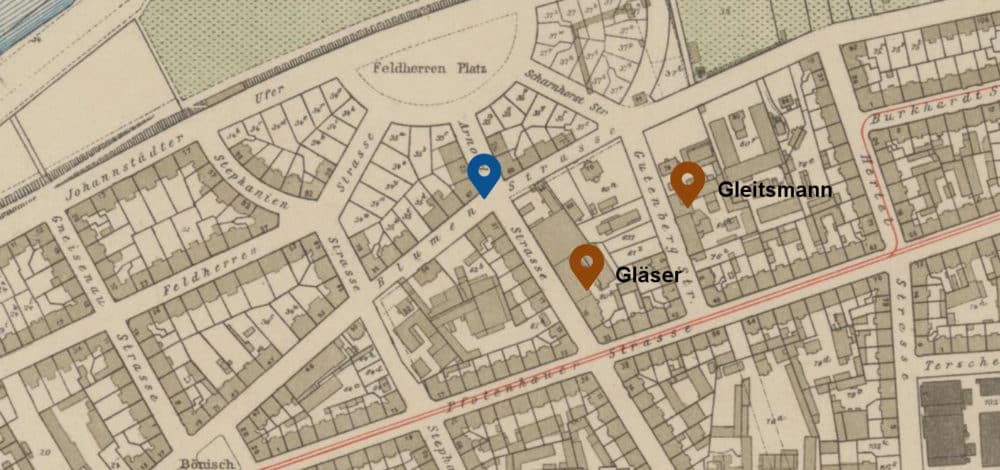
Arnoldstraße
Die Arnoldstraße führt von der Gerokstraße vorbei am Trinitatisfriedhof bis zum Thomas-Müntzer-Platz. Sie ist seit 1893 nach Johann Christoph Arnold (1763–1847) benannt. Arnold betätigte sich als Verleger, Zeitungsbesitzer, Kunstmäzen und Stadtpolitiker. Er war außerdem Begründer der Arnoldischen Buchhandlung. Zu Zeiten des Nationalsozialismus trug der bebaute Teil der Arnoldstraße den Namen Litzmannstraße. Der NSDAP-Reichstagsabgeordnete und General der Infanterie Karl Litzmann (1850–1936) wirkte auch als letzter Alterspräsident der Weimarer Republik. Am 24. Juli 1945 erfolgte die Rückbenennung.
Am 1. August 1898 eröffnete in der Nr. 1 eine Kinderpoliklinik als weltweit erste Poliklinik zur stationären Behandlung von Säuglingen, die Arthur Schloßmann führte. Schloßmann gewährte in seiner Klinik „im Falle der Noth auch freie Arzneimittel und Heilmittel“. Das Ziel der Klinik bestand in der Senkung der Säuglingssterblichkeit durch eine poliklinische Betreuung und Verbesserung der Säuglingsernährung. Hier verwendete das Klinikpersonal erstmals Wärmeeinrichtungen zur Versorgung von Frühgeburten, Vorläufer der heute gebräuchlichen Inkubatoren. Aus Schloßmanns Einrichtung ging die heutige Kinderklinik am Universitätsklinikum hervor.
Weitere Informationen zur Geschichte der Arnoldstraße finden Sie hier.
Fahrzeuge von Gläser
Eines der prägendsten Unternehmen in der Arnoldstraße war das 1864 gegründete Karosseriewerk von Heinrich Gläser. Als Königlicher Hoflieferant belieferte das Werk u. a. den Königlichen Marstall und das Königliche Oberstallamt, zunächst mit Kutschenwagen. Mit dem Radeberger Schmied Emil Heuer als Teilhaber produzierte die Fabrik um 1900 jährlich etwa 20 Kutschwagen in luxuriöser Ausfertigung. 1904 begann die Serienmontage von Automobil-Limousinen. Die erste königliche Limousine verließ ein Jahr später in der hier entwickelten Triple-Phaeton-Bauform (offenes Fahrzeug mit drei Sitzreihen) die Werkstatt. Über die Jahre entwickelte sich das Unternehmen zum Spezialisten für Cabriolet-Karosserien und fertigte Prototypen für unterschiedliche Auftraggeber, darunter Mercedes, DKW, Horch und Wanderer. Infolge der Weltwirtschaftskrise und sinkender Verkaufszahlen von Luxuskarossen musste Heuer 1933 Konkurs anmelden. Die unter seinem Schwiegersohn Willy Bochmann neu gegründete „Gläserkarosserie G.m.b.H.“ sicherte sich 1935 lukrative Aufträge der Wehrmacht und stellte in den Kriegsjahren komplett auf Rüstungsproduktion um. Kurzzeitig gab es hier auch ein Arbeitserziehungslager der SS für männliche Inhaftierte.
Weitere Informationen zur Geschichte des Karosseriewerkes finden Sie hier.
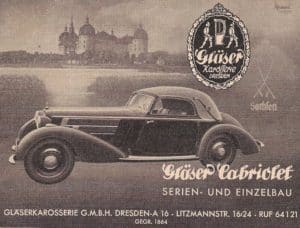
Farben von E. T. Gleitsmann
Die von Emil Theodor Gleitsmann 1858 gegründete chemische Fabrik für trockene Farben verlagerte sich 1867 nach Dresden und erstreckte sich bereits um 1900 auf der Gutenbergstraße über mehrere Grundstücke auf 8.000 Quadratmetern Fläche. Die Firma produzierte Buntfarben für den Buch- und Steindruck sowie Farbfertigprodukte. Außerhalb der Gutenbergstraße befanden sich noch eine Leinölfirniskocherei mit Öllagerräumen, zwei Rußbrennereien und eine Harzdestillation. Neben hochwertigen Standarddruckfarben produzierte E. T. Gleitsmann auch Sicherheitsdruckfarben für Banknoten und Briefmarken. Mit zunehmendem Erfolg gründete die Firma bis 1920 Niederlassungen in Italien, Schweden und Österreich. Derzeit ist sie in Bayern ansässig.
Weitere Informationen zur Geschichte der Farbenfabriken E. T. Gleitsmann finden Sie hier.
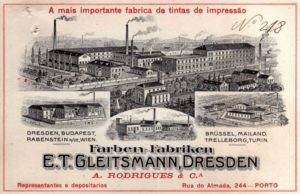
Nach 1945: Wartburg und Bildung
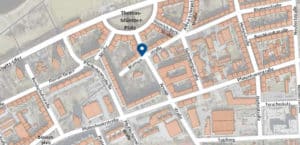
Aus Gläser wird ein VEB
Die Bomben auf Dresden am 13. und 14. Februar 1945 zerstörten auch die Betriebsstätten der „Gläserkarosserie G.m.b.H.“ Nach der notdürftigen Wiederherstellung einiger Werkstätten in der Arnoldstraße fertigten etwa 40 verbliebene Mitarbeiter Rucksäcke und Taschen, während sich die Stellmacher auf Hand- und Leiterwagen spezialisierten. Außerdem begann man mit der Reparatur von Kfz-Aufbauten. Die ersten größeren Aufträge des Werkes waren vier „6-Fenster-Pullman-Limousinen“ für den russischen Stadtkommandanten sowie 25 dringend benötigte DKW F 8-Lieferwagen.
1953 vereinigten sich die Gläser-Werke in Radeberg und Dresden zum VEB Karosseriewerk Dresden mit der Produktionsmarke Industrieverband Fahrzeugbau (IFA). In das Produktionsprogramm kamen neben dem IFA-F 8 später Karosserieteile für die Limousinenausführung des P 70 und ab 1956 der Wartburg 311.2 Cabriolet. Die Rohbaufertigung erfolgte im Dresdner Fertigungsbereich auf der Industriestraße, Lackierung und Montage der Karosserie auf das Chassis mit einer neuen Taktstraße in der Arnoldstraße. 1963 beschichtete das Karosseriewerk erstmals Wartburg-Teile mittels Zweischicht-Kunstharz-Fließfertigung. Ab 1967 begann die Serienproduktion des Wartburg W 353 Tourist.
1991 stellte das Werk die Fahrzeugproduktion am Standort Arnoldstraße ein. Im Jahr 1994 erfolgte die Reprivatisierung als Karosseriewerke Dresden GmbH (KWD) mit alleinigem Standort in Radeberg. Nach Abriss der Nebengebäude und Umbau des verbliebenen Verwaltungsgebäudes mieteten sich verschiedene Unternehmen in dem Haus ein, unter anderem bis 2018 auch die stadtbekannte Spielekneipe Triangel.
Weitere Informationen zur Geschichte des Karosseriewerkes finden Sie hier.
|
|
Aus E. T. Gleitsmann wird die SGB
Auf dem Gelände der Farbenfabrik E. T. Gleitsmann entstand nach der Beseitigung der größten Kriegsschäden im Jahr 1949 die Betriebsberufsschule Neues Leben des Industriezweiges Lacke und Farben. Aus Umstrukturierungen der Berufsschule gingen 1983 die Hauptabteilung Bildung des VEB Kombinat Lacke und Farben und 1991 schließlich die Sächsische Bildungsgesellschaft für Umweltschutz und Chemieberufe Dresden mbH (SBG) hervor.
Nach der Privatisierung der SBG über den Verein zur Förderung gemeinnütziger Bildungs- und Beschäftigungsmaßnahmen Dresden e.V. im Jahr 1992 übernahm 2013 die Stiftung „Zukunft durch Bildung“ die alleinige Gesellschafterrolle für diesen traditionsreichen Johannstädter Bildungsstandort. Die SBG spielt heute eine zentrale Rolle bei der Aus- und Weiterbildung in naturwissenschaftlichen und umwelttechnischen Berufen. Über 120 Partner aus produzierenden Unternehmen und Forschungseinrichtungen der Chemie-, Pharmazie- und Biowirtschaft sowie der Wasser-, Abwasser- und Kreislaufwirtschaft lassen hier u. a. ihre Lehrlinge und Meister ausbilden. Zum Aufgabengebiet der SBG gehört auch die berufliche Bildung von Malern und Lackierern.
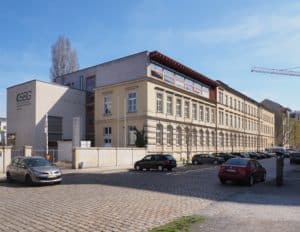
Text: Matthias Erfurth, Matthias Kunert, Henning Seidler
Redaktionsschluss: Januar 2024
